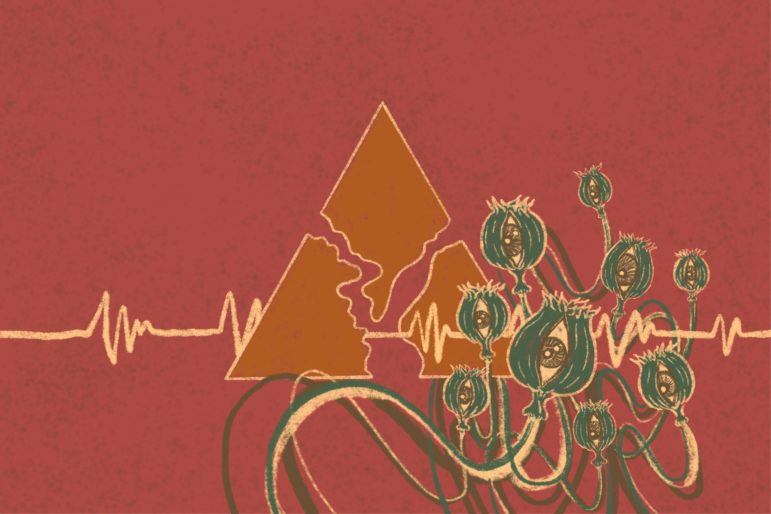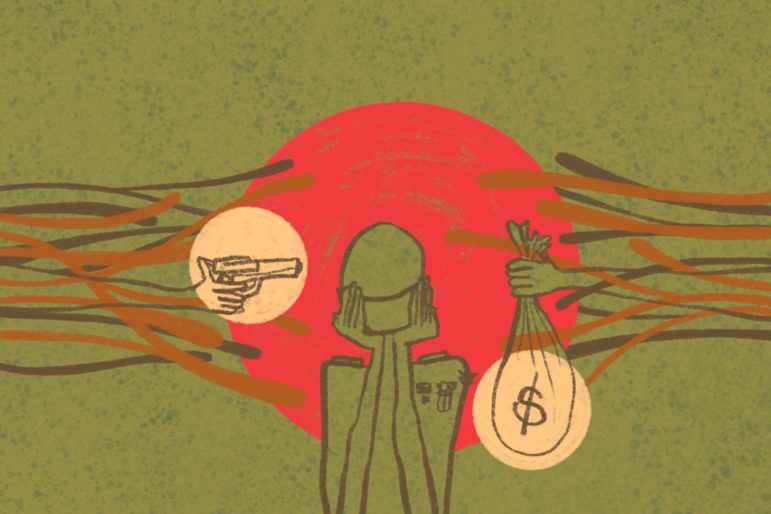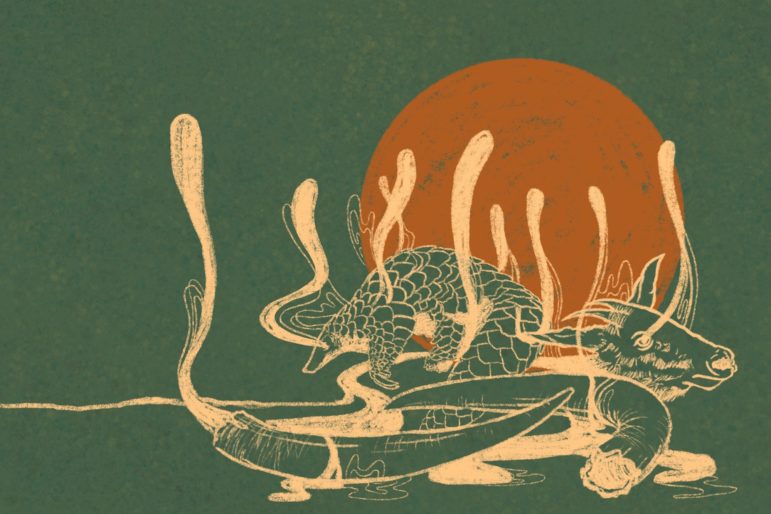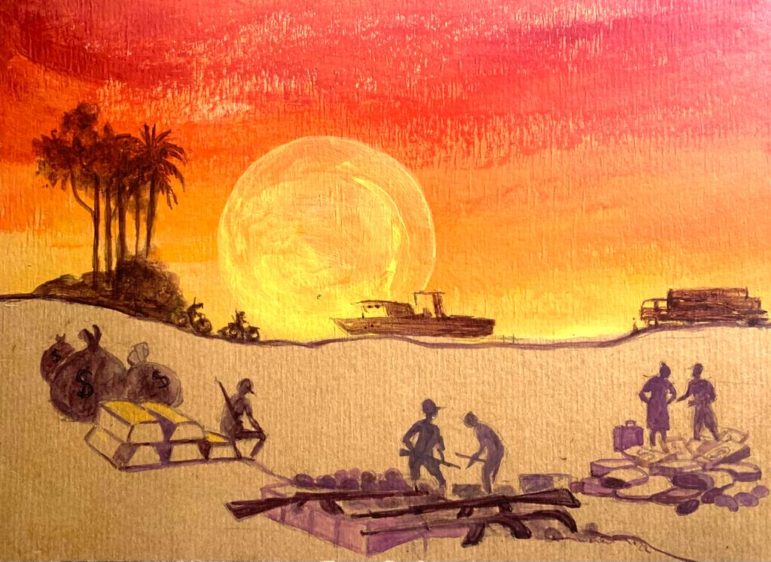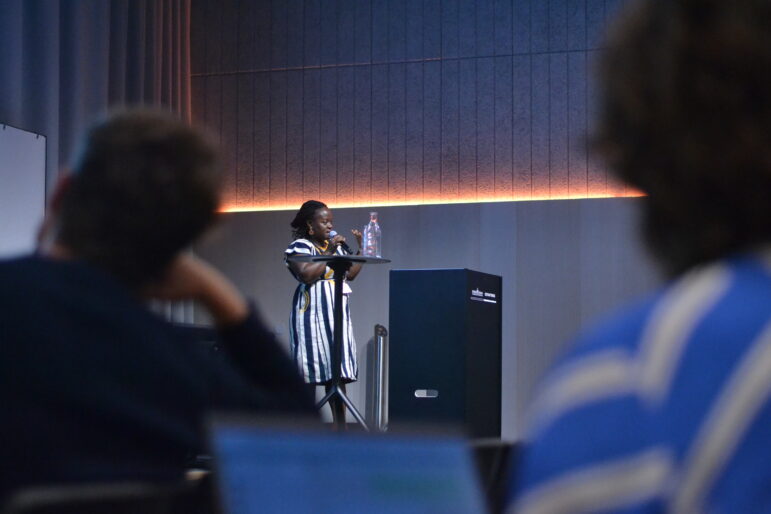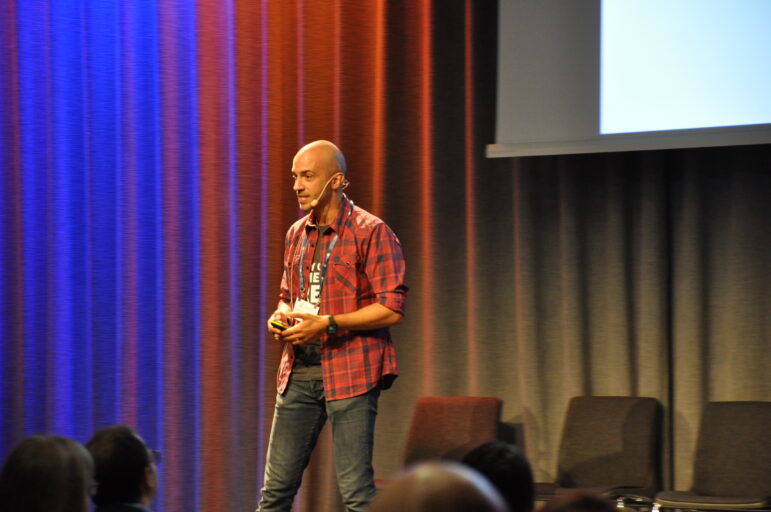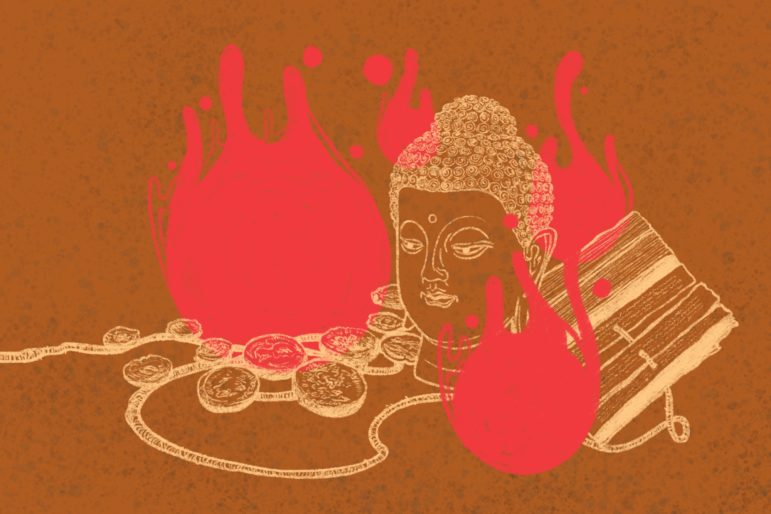

Illustration: Nodjadong Boonprasert for GIJN
Guide to Investigating Organized Crime in the Golden Triangle: Chapter 6 — Other Criminal Activity
Chapter Guide Resource
Guide to Investigating Organized Crime in the Golden Triangle — Introduction
Chapter Guide Resource
Guide to Investigating Organized Crime in the Golden Triangle: Chapter 1 — Drug Trafficking
Chapter Guide Resource
Guide to Investigating Organized Crime in the Golden Triangle: Chapter 3 — Money Laundering
Chapter Guide Resource
Guide to Investigating Organized Crime in the Golden Triangle: Chapter 4 — Human Trafficking
Chapter Guide Resource
Video: Investigating Organized Crime in the Golden Triangle
Table of Contents | Introduction | Chapter 1 | Chapter 2 | Chapter 3 | Chapter 4 | Chapter 5
Apart from being notorious for drug trafficking, wildlife smuggling, and illegal migration, the Golden Triangle has also become one of the world’s leading areas for unlawful mining, logging, antiquities trading, and arms production.
Mining for rare earth metals is by far the most lucrative of those illicit activities. Rare earth metals are essential ingredients in such products as cell phones, computers, electric vehicles, and defense applications such as guidance systems, lasers, radar, and sonar.
The mining in Myanmar is illegal because no official export licenses are issued, but the military turns a blind eye to it because of its ceasefire agreement with the United Wa State Army (UWSA), which controls most of the mines. Rare earth mining especially has become a major income for the UWSA, possibly rivaling the drug trade in profitability. China is the main destination of these minerals, which are used in the electronics industry without foreign customers knowing where they came from. Jade, too, has been smuggled to Thailand and China for decades, but that trade could be considered semi-legal as some miners and traders do have export licenses.
Antiquities such as ancient Buddha statues, palm leaf scriptures, and other items from temples, as well as old coins, jewelry, and artifacts, are routinely smuggled into Thailand from Myanmar. The illegal trade in antiquities has become more difficult because of international supervision and restrictions on the importation of such goods into primarily Western countries. But there is a slow but growing demand in China for particular types of ancient, line decorated beads, which apparently can only be found in historical sites in Myanmar and are of religious significance.
Timber trading in the 1990s and early 2000s was a massive enterprise in the region with entire areas inside Myanmar being denuded. The practice, which had both legal and illegal aspects, has declined in recent years, though, because of export restrictions put in place by China — the main destination for illicit logging — and the fact that much of the forests in northern and northeastern Myanmar are now gone. The exact value of the trade in all these goods is not known, but, put together, it is likely close to billions of US dollars.
Guns are produced in clandestine factories in Shan and Kachin States and are both sold and used locally. Gun production is still important as a source of income for the former Communist Party of Burma (CPB) rebel group in Kachin State, while the Kachin Independence Army (KIA) and the UWSA produce guns for use in their own armed forces from raw material smuggled in from China and with the help of Chinese engineers. Some of these regionally-produced guns have also found their way to ethnic rebel groups in Nagaland and Manipur in northeastern India as well, making the production an issue of regional concern.
The lawless nature of the Golden Triangle caused by decades of civil war has, somewhat ironically, been exacerbated by the ceasefire agreements the Myanmar military has signed with various rebel groups since 1989. The establishment of autonomous zones for the former rebel groups — along with promises that they can run any kind of business to support themselves — has turned the Golden Triangle into a haven for every imaginable kind of crime. The dramatic rise in narcotics production, first opium, then heroin, and now methamphetamine, has been followed by a multi-million dollar trade in minerals.
‘Blood Jade’ Trade
The jade trade is the oldest of any mining activity within the present borders of Myanmar. High-quality, imperial green jade can be found only in the Hpakant area of western Kachin State, and it has been mined there for more than 1,000 years. Jade has an almost religious significance in Chinese culture, where it is known as the “Stone of Heaven” and the main market, therefore, has always been China. Only wars and revolutions have disrupted the trade. When the border has been open, the trade has been legal. But when the borders have been closed — for instance, during the military’s “Burmese Way to Socialism” era (1962-1988) — jade trading was technically illegal, but still took place because of corruption within Myanmar’s ruling military. Even today, some jade is exported to China illegally to avoid paying taxes and other duties.
The end of the Chinese civil war and the proclamation of the People’s Republic of China in 1949 brought cross-border trade to a halt, and it was not resumed until the early 1990s when China as well as Myanmar introduced free-market reforms. Until then, jade had been smuggled from northern Myanmar to Chiang Mai in northern Thailand, which became the center for the regional jade trade. Once in Thailand, the commodity was no longer considered contraband and exporters could legally trade the stone to buyers in Hong Kong, Taiwan, and Singapore.

A large mass of jade prepped for carving in Chiang Mai. Illegally mined jade from Myanmar is often smuggled across the border into northern Thailand. Image: Flickr (Creative Commons 2.0)
The Kachin State town of Hpakant technically does not sit within the Golden Triangle, but the illegal jade trade originating from there has been carried out by various rebel armies and militias, some of which were also involved in the drug trade. The KIA has controlled the area around the mines (but not the actual mines), enabling it to collect taxes on the trade. For many decades, jade mining was officially illegal under Myanmar law but still tolerated because it brought in massive incomes to corrupt local government officials. The KIA also transported jade by mule caravans down to the Thai border where Nationalist-Chinese Kuomintang (KMT) militias had their camps.
Those camps themselves were not illegal; the Thais recognized the KMT as special border guard forces and mostly ignored the militia’s commercial activities, be it trafficking drugs or jade. One prominent KMT officer had a camp at Tam Ngob on the Myanmar border as well as a mansion in Chiang Mai, and he was involved in the drug trade as well as the jade business. The KIA, which also had a camp at Tam Ngob, was paid for its services and could buy guns in Thailand, which then were transported back into Kachin State by the same mule caravans that had carried jade down to the border. Another KMT general had a similar camp at Mae Salong, northwest of the northern Thai city of Chiang Rai. Golden Triangle drug lords such as Lo Hsing-han and Khun Sa also doubled as jade traders, and the jade trade became in all aspects closely linked to the trade in opium and heroin.
Today, jade trafficking has become a multi-billion-dollar business. Chiang Mai, however, has lost its significance as a trading hub since the jade is now transported directly across the border into China, or sold at official jade and gems auctions in Myanmar. The entire area around Hpakant has been turned into a moon-like landscape, and various private entrepreneurs — including Golden Triangle drug traffickers — are making vast fortunes from the trade, while working conditions at the mines are abysmal, leaving a trail of deaths. Some journalists and authors, therefore, have begun writing about the business as the battle for “blood jade.”
Rare Earth Mining
The ceasefire agreements between the Myanmar military and various rebel groups in the late 1980s and early 1990s laid the groundwork for other illegal and informal mining activities as well.
In a September 2021 report, the commodity research firm Roskill estimated that, as of 2020, at least half of Chinese-made electronics that require heavy rare earth elements (HREE) used minerals imported from Myanmar. In fact, the report stated that “all Chinese state-owned enterprises (SOEs), except for those focusing on light rare earths, have become reliant on Myanmar sources over the past four years, and now face supply chain risks with few alternative suppliers of HREE resources.”
Most rare earth mines are located in areas under UWSA or New Democratic Army-Kachin (NDA-K) control. The latter is an armed group of former CPB forces that also made peace with the Myanmar military in 1989. Led by a former CPB commander, the NDA-K has its headquarters at Pangwa on the Chinese border and, in 2009, became a Border Guard Force allied with the Myanmar military. There are also at least two mines in KIA-controlled areas near the Chinese border, but their output there is limited compared with what is being extracted in the Pangwa area.
In addition, there are rare earth mines in other parts of the country that could be considered legitimate, as they are run under more direct supervision of the Myanmar government. Myanmar is, in fact, the world’s third-largest producer of rare earth metals after the United States and China. China, despite being the most prolific rare earth metal producer, is still heavily dependent on imports from Myanmar, including illegally trafficked rare earth minerals from militia-controlled border areas.
Illegal Logging
One consequence of the freedom granted to militia groups after the cease-fire agreements of the late 1980s and early 1990s was a boom in illegal logging. Hundreds of loaded timber trucks could be seen daily heading back into China from Myanmar’s sector of the Golden Triangle. The NGO Global Witness documented this practice and estimated that, in 2006, this illegal logging was worth US$250 million per year — and that 95% of Myanmar wood exports to China lacked licences and failed to pay the necessary taxes or duties. Since then, there has been a significant decline in those exports, but timber remains a notable source of income for several rebel groups and militias in the Golden Triangle.
Arms Production and Dealing
Another illegal activity that has taken off in recent years is the production and trade in weapons. Myanmar’s rebel groups have always had the capacity to repair old guns and make their own rifle ammunition and land mines, but, more recently, clandestine gun factories have been established in the Golden Triangle and adjacent areas. The first known such facility was set up in September 2006 near Kunma, 125 kilometers north of the UWSA’s headquarters at Panghsang on the Chinese border. It was reported to be manufacturing replicas of Chinese-designed M-22 assault rifles (the Chinese version of Russia’s AK-47, or Kalashnikov), M-23 light machine guns, and the 7.62-millimeter ammunition used by both weapons. Raw material and spare parts, as well as the technical expertise needed for the production, comes from China, and it is uncertain to what extent Chinese authorities are complicit in this gun trade. However, most of the weaponry in the UWSA’s arsenal — including infantry weapons, artillery, light armored cars, surface-to-air missiles, and even weaponized drones — are acquired from China.
The KIA, which does not have the same close relationship with the Chinese as the UWSA, has its own weapons factory where it produces assault rifles also based on Chinese designs and manufactured with raw material and parts from China. Those guns are used by the KIA’s troops and not sold to other rebel armies or militias. The KIA entered into a ceasefire agreement with the Myanmar military in 1994, but it fell apart in June 2011, and since then, heavy fighting has raged in northernmost Myanmar.
The NDA-K, with its headquarters at Pangwa, became a major player in a number of trafficking businesses soon after its ceasefire agreement in 1989. However, its lucrative trade in illicit timber deteriorated quickly once the forests were depleted, forcing the group to turn to poppy cultivation and heroin production. Today, as a Border Guard Force allied with the Myanmar military, the NDA-K remains active in the drug trade and has also established a gun factory at Pangwa that produces automatic rifles, pistols, revolvers, and shotguns. Among its arms customers are the ethnic Naga, Assamese, and Manipuri rebels from northeastern India, who have bases on the Myanmar side of the border in the upper Sagaing Region of that country. The group’s guns and drugs are transported through areas of Kachin State that are not controlled by the KIA — to avoid that local militia’s taxes on the goods — then up to Singkaling Hkamti in Sagaing Region and on to the rebel camps closer to the Indian border.
In addition, imported guns from China are also smuggled across the Myanmar border at Ruili and then to Muse and Lashio in northern Shan State, destined for Mandalay, Monywa, or the Indian border. Weapons from Thailand are also found all over the Golden Triangle and other border regions.
Antiquities Looting and Trafficking
Antiquities are among the other items being smuggled out of Myanmar, through the Golden Triangle and other areas, and then on to Thailand and China. Shops selling antiquities from Myanmar can be seen in Chiang Mai as well as in Bangkok. Antiquities looting in Myanmar likely dates back to the British colonial era (which ended in 1948), but in more recent years it has become a very lucrative business. International efforts to combat the trade have produced some results, but it remains a profitable business for criminal gangs operating in the region.
Tips and Tools
Investigating activities such as jade and rare earth mining, illegal logging, arms production and dealing, and the illicit trade in antiquities requires the same precautions as doing research into the drug trade. Utmost care has to be taken and local sources must be protected.
However, the best way to start is to use internet sources, and logging is the best documented of all those activities. Global Witness has produced numerous reports on the illicit trade in timber in Myanmar, which can be found here, here and here. Data about the trade can also be found in a joint study by the European Forest Institute (EFI), the EU’s Forest Law Enforcement, Governance and Trade (FLEGT) agency, and Southwest Forestry University in China, led by researchers from both China and Myanmar.
Global Witness has also published several reports on the trade in rare earth metals and its effects on the local environment and the involvement in the business of Myanmar-military linked militias. Resources Policy, a publication that monitors mining around the world, has produced a comprehensive report on the illegal and informal trade in various minerals to China.
There are no comprehensive reports on the gun trade, only articles written by investigative journalists (see the Case Studies section). UNESCO has produced a report on the illegal trade in antiquities. There is also a good report on the local trade in looted items published by Teacircle, a group based in Oxford, England.
The best way forward after consulting these internet resources would, as usual, be to talk to trusted local journalists and NGO workers. Because of new restrictions and increased surveillance of foreign visitors in China, especially in border provinces such as Yunnan, it has become very difficult, and risky, to conduct fieldwork in those areas. The Chinese have installed cameras on major border crossing points, and any foreigner seen in Ruili, Tengchong, and other Yunnan border towns would be closely watched by the special branch of the police. Northern Thailand, though, is more easily accessible, as are the northeastern Indian states of Nagaland, Manipur, and Mizoram, which are now open after being closed to foreigners for decades. Special permits are required only for the state of Arunachal Pradesh. Local law enforcement officers in Thailand should be avoided as they’re not trustworthy, but it is possible to get accurate information from police officials in India.
Case Studies
In August 2022, the Associated Press published a very informative article about the environmental impact of rare earth mining in Myanmar, and the price the country has paid for the West’s embrace of green energy. The article states that Myanmar has become a “sacrifice zone” that destroys itself for “the good of the world.”
The dual problem of money laundering and arms production was covered by the Myanmar website Mizzima in October 2022. It reported that “manufacturing of war armaments have become a part of the vicious circle of the armed conflict raging in Myanmar,” and that some of the guns manufactured by the UWSA have been sold to ethnic insurgents in Myanmar and northeastern India.
Other investigative reports on gun manufacturing and the weapons trade can be found here, here and here. Those three reports were based on interviews conducted in the Myanmar capital Yangon with former militia commanders from Pangwa and supported by documentation provided by them, including photographs of the local gun factory and heroin refinery.
Table of Contents | Introduction | Chapter 1 | Chapter 2 | Chapter 3 | Chapter 4 | Chapter 5
Additional Resources
Reporter’s Guide to Investigating Organized Crime
Investigating Antiquities Trafficking
Investigating Arms Trafficking
 Bertil Lintner is the author of 22 books on Asian history, politics, and crime. He is currently with Asia Times and a former correspondent with the Far Eastern Economic Review, the Swedish daily Svenska Dagbladet, and Jane’s Information Group in the UK. Lintner lives with his family in Chiang Mai, northern Thailand.
Bertil Lintner is the author of 22 books on Asian history, politics, and crime. He is currently with Asia Times and a former correspondent with the Far Eastern Economic Review, the Swedish daily Svenska Dagbladet, and Jane’s Information Group in the UK. Lintner lives with his family in Chiang Mai, northern Thailand.

